



In today's blog, I will offer a more general definition that is taken from Matrices and Linear Transformations by Charles G. Cullen.
Before offering this definition, I need to establish some notation for elementary operations of matrices. See here for review of these elementary operations.
Definition 1: A(kRi)
This is the matrix that results from multiplying a scalar k to the ith row of the matrix A.
Definition 2: A(Ri ↔ Rj)
This is the matrix that results from interchanging row i with row j in the matrix A.
Definition 3: A(kRj + Ri)
This is the matrix that results from adding (a scalar k * row j) to row i in the matrix A.
Now, I can use these definitions to offer a more general definition of the determinant of an n x n matrix:
Definition 4: Determinant of an n x n matrix A det(A)
A function is said to be the determinant of an n x n matrix if:
(I) det(AB) = det(A)*det(B)
(II) det(I(kR1)) = k
NOTE: I(kR1) is the identity matrix In with k multiplied to row 1 in I. [See here for details on how modifying the identity matrix and how this relates to elementary operations.]
For example, I(5R1) =

since for identity I2:

Now, from our previous result, we have shown that the above rule applies to 2 x 2 matrices.
Lemma 1: 2 x 2 matrices are determinants by Definition 4 above
Proof:
(1) Let A, B be 2 x 2 matrices.
(2) det(AB) = det(A)det(B) [See Lemma 1 here]
(3) I(kR1) =

(4) Using the definition of determinant for 2 x 2 matrices gives us:
k*1 - 0*0 = k
(5) Thus, we have shown that our proposed definition is consistent with the previous definition for 2 x 2 matrices.
QED
Lemma 2: I(kRj) = I(Rj ↔ R1)I(kR1)I(Rj ↔ R1)
Proof:
(1) I =
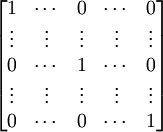
(2) I(Rj ↔ R1) =
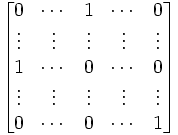
(3) I(kR1)I(Rj ↔ R1)
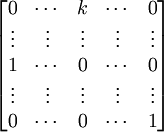
(4) I(Rj ↔ R1)I(kR1)I(Rj ↔ R1)
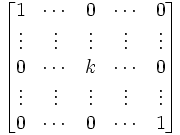
QED
Lemma 3: I(Rj ↔ R1)I(Rj ↔ R1) = I.
Proof:
(1) I =

(2) I(Rj ↔ R1) =

(3) I(Rj ↔ R1)I(Rj ↔ R1) =

QED
Lemma 4: det(I(kRj)) = k
Proof:
(1) det(I(kRj)) = det( I(Rj ↔ R1)I(kR1)I(Rj ↔ R1) ) [See Lemma 2 above]
(2) det( I(Rj ↔ R1)I(kR1)I(Rj ↔ R1) ) = det( I(Rj ↔ R1) )det( I(kR1) )det( I(Rj ↔ R1) ) [See Definition 4 above]
(3) det( I(Rj ↔ R1) )det( I(kR1) )det( I(Rj ↔ R1) ) = det( I(kR1) )det( I(Rj ↔ R1) )det( I(Rj ↔ R1) ) [from the Commutativity of scalars]
(4) det( I(kR1) )det( I(Rj ↔ R1) )det( I(Rj ↔ R1) ) = det( I(kR1) )det( I(Rj ↔ R1)I(Rj ↔ R1) ) [ See Definition 4 above]
(5) det( I(kR1) )det( I(Rj ↔ R1)I(Rj ↔ R1) ) = det( I(kR1) )det(I) [See Lemma 3 above]
(6) det( I(kR1) )det(I) = det(I(kR1))det(I(1R1))
(7) det( I(kR1))det(I(1R1)) = k*1 = k [See Definition 4 above]
QED
Corollary 4.1: A = I(kRj)B → det(A) = k*det(B)
Proof:
(1) A = I(kRj)B
(2) det(A) = det(I(kRj)B) = det(I(kRj))det(B) = k*det(B) [See Lemma 4 above]
QED
Corollary 4.2: det(I(0Ri)) = 0
Proof:
(1) det(I(0Ri)) = 0 [This follows directly from Lemma 4 above for k=0]
QED
Corollary 4.3: det(I) = 1
Proof:
(1) det(I) = det(I(1Ri)) = 1. [This follows directly from Lemma 4 above for k = 1]
QED
Lemma 5: I(kRj + Ri) = I(k-1Rj)I(1Rj + Ri)I(kRj)
Proof:
(1) I(kRj + Ri) =
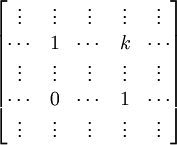
(2) I(kRj) =
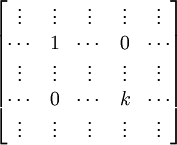
(3) I(1Rj + Ri)I(kRj) =
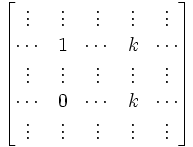
(4) I(k-1Rj)I(1Rj + Ri)I(kRj) =

QED
Lemma 6: I(k-1Rj)I(kRj) = I
Proof:
(1) I(kRj) =
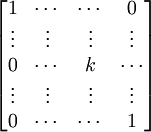
(2) I(k-1Rj)I(kRj) =
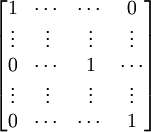
QED
Lemma 7: det(I(kRj + Ri)) = 1
Proof:
(1) Assume k = 0
(2) det(I(kRj + Ri)) = det(I(0Rj + Ri)) = det(I) = det(I(kR1)) = 1 [See Definition 4 above]
(3) Assume k ≠ 0
(4) det(I(kRj + Ri)) =det( I(k-1Rj)I(1Rj + Ri)I(kRj) ) [See Lemma 5 above]
(5) det( I(k-1Rj)I(1Rj + Ri)I(kRj) ) = det( I(k-1Rj) )det( I(1Rj + Ri) )det( I(kRj) ) [See Definition 4 above]
(6) det( I(k-1Rj) )det( I(1Rj + Ri) )det( I(kRj) ) = det( I(1Rj + Ri) )det( I(k-1Rj) )det( I(kRj) ) [from the Commutativity of scalars]
(7) det( I(1Rj + Ri) )det( I(k-1Rj) )det( I(kRj) ) = det( I(1Rj + Ri) )det( I(k-1Rj) I(kRj) ) [see Definition 4 above]
(8) det( I(1Rj + Ri) )det( I(k-1Rj) I(kRj) ) = det( I(1Rj + Ri) )det( I ) [See Lemma 6 above]
(9) det( I(1Rj + Ri) )det( I ) = det( I(1Rj + Ri) I) = det(I(1Rj + Ri)) [See Definition 4 above]
(10) So, we have shown that: det(I(kRj + Ri)) = det(I(1Rj + Ri))
(11) Now, (I(1Rj + Ri))2 = (I(1Rj + Ri))(I(1Rj + Ri)) = I(2Rj + Ri)
(12) But for k=2, we have:
det( (I(1Rj + Ri))(I(1Rj + Ri))) = det(I(2Rj + Ri) ) = det(I(1Rj + Ri))
(13) Now, this can only be true if det(I(1Rj + Ri)) = 0 or det(I(1Rj + Ri)) = 1.
(14) We note that I(1Rj + Ri)I(-1Rj + Ri) = I.
(15) Since det(I) = 1, it follows that det(I(1Rj + Ri)I(-1Rj + Ri)) = 1 so it is impossible for det(I(1Rj + Ri)) = 0.
(16) Therefore, det(I(1Rj + Ri)) = 1.
QED
Corollary 7.1: A = I(kRj + Ri)B → det(A) = det(B)
Proof:
(1) A = I(kRj + Ri)B
(2) det(A) = det(I(kRj + Ri)B) = det(I(kRj + Ri))det(B) = 1*det(B) = det(B) [See Lemma 7 above]
QED
Lemma 8: I(Ri ↔ Rj) = I(-Ri)I(1Ri + Rj)I(-Rj + Ri)I(1Ri + Rj)
Proof:
(1) I(Ri ↔ Rj) =
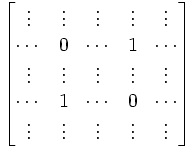
(2) I(1Ri + Rj) =
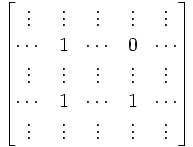
(3) I(-Rj + Ri)I(1Ri + Rj) =
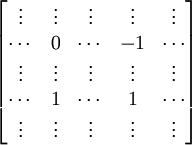
(4) I(1Ri + Rj)I(-Rj + Ri)I(1Ri + Rj) =
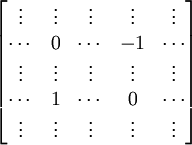
(5) I(-Ri)I(1Ri + Rj)I(-Rj + Ri)I(1Ri + Rj) =

QED
Lemma 9: det(I(Ri ↔ Rj)) = -1.
Proof:
(1) det( I(Ri ↔ Rj) ) = det( I(-Ri)I(1Ri + Rj)I(-Rj + Ri)I(1Ri + Rj) ) [See Lemma 8 above]
(2) det( I(-Ri)I(1Ri + Rj)I(-Rj + Ri)I(1Ri + Rj) ) = det( I(-Ri) )det( I(1Ri + Rj) )det( I(-Rj + Ri) )det( I(1Ri + Rj) ) [See Definition 4 above]
(3) det( I(-Ri) ) = -1 [See Lemma 4 above]
(4) det( I(1Ri + Rj) ) = det( I(-Rj + Ri) ) = 1 [See Lemma 7 above]
(5) So, det( I(-Ri) )det( I(1Ri + Rj) )det( I(-Rj + Ri) )det( I(1Ri + Rj) ) = (-1)*(1)*(1)*(1) = -1.
QED
Corollary 9.1: A =I(Ri ↔ Rj)B → det(A) = -det(B).
Proof:
(1) A =I(Ri ↔ Rj)B
(2) det(A) = det(I(Ri ↔ Rj)B) = det(I(Ri ↔ Rj))det(B) = (-1)*det(B) = -det(B)
QED
Lemma 10:
Let Ei be an elementary matrix
Let A =

then:
det(A) = det(Ei)
Proof:
(1) There are only three types of elementary matrices so this proof is complete if I show it is true for each type.
(2) Type I: Ei = I(kRi)
(a) From Lemma 4 above, det(Ei) = k
(b) A, in this case, is equal to I(kRi+1)
(c) Using Lemma 4 above, det(A) = k
(3) Type II: Ei = I(kRj + Ri)
(a) From Lemma 7 above, det(Ei) = 1
(b) A, in this case, is equal to I(kRj+1 + Ri+1)
(c) Using Lemma 7 above, det(A) = 1.
(4) Type III: Ei = I(Ri ↔ Rj)
(a) From Lemma 9 above, det(Ei) = -1.
(b) A, in this case, is equal to I(Ri+1 ↔ Rj+1)
(c) Using Lemma 9 above, det(A) = -1
QED
References
- Charles G. Cullen, Matrices and Linear Transformations
, Dover Publications, Inc., 1972.
No comments :
Post a Comment